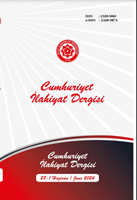İbn Kesîr’in el-Bidâye ve’n-nihâye’sinin Siyer Kısmında Bazı Sahîhayn Hadislerini Muhteva Tenkidinin Tahlili
Analysis of Ibn Kathīr’s Content Criticism of Some of the Sahîhayn Ḥadīths in the Sīra section of Al-Bidāya wan Nihāya
Author(s): Mehmet Ali ÇalganSubject(s): History of Islam, Sociology of Religion, History of Religion
Published by: Cumhuriyet Üniversitesi İlahyat Fakültesi
Keywords: Ḥadīth; Matn Criticism; Content criticism; Ibn Kathīr; Al-Bidāya wan Nihāya;
Summary/Abstract: The purpose of this study is the examination and analysis of Ibn Kathīr’s (d. 774/1373) criticism of Sahihayn ḥadīths with respect to their content in the Sīra section of his history work called AlBidāya wan Nihāya. The subject of the study is Ibn Kathīr’s criticism of twenty Sahihayn ḥadīths using the criteria of conformity/contradiction with the Qurʾān, authentic ḥadīths, reasoning, historical facts and id̲j̲māʿ and his argument that the problems that he could not explain in fourteen ḥadīths were mistakes. The information that Ibn Kathīr provides about the rāwīs’ interventions which make the examined ḥadīths susceptible to content criticism, is also valuable. Seven of the ḥadīths that are in the scope of this study are in both Sahih al-Buk̲h̲ārī and Sahih Muslim, six are only in Sahih al-Buk̲h̲ārī and seven are only in Sahih Muslim. The ḥadīths in both Sahih al-Buk̲h̲ārī and Sahih Muslim include those ḥadīths on the following subjects: the prohibition of the nikah mut’ah in K̲h̲aybar, the intention of the Prophet (pbuh) for ʿumra and ḥad̲j̲d̲j̲, the Prophet throwing away the silver ring, the news of the change of ḳibla reaching Qubāʾ the next morning, the time of the ban on speaking during prayer and the piercing of the wall of Yād̲j̲ūd̲j̲wa-mād̲j̲ūd̲j̲. The ḥadīths mentioned only in Sahih al-Buk̲h̲ārī include those on the following subjects: the realization of Isrāʾ before the revelation, the number of those who participated in the battle of Hamra al-Assad, Saʿd b. Abī Waḳḳāṣ’s entry into Islam, Ali’s allegiance to Abū Bakr, information about the expedition of al-Raji and the omission of the journey to Bayt al-Maqdis in the ḥadīth of the ascension. The ḥadīths mentioned only in Sahih Muslim include those on the following subjects: the number of the participants in the battle of Ḥunayn, the creation of the earth in seven days, ʿAmr b. ʿAbese’s entry into Islam, consultation with Saʿd b. ʿUbāda for the battle of Badr, ṣaḥāba’s complaint about the hot sands, marriage with Umm Ḥabība and the place of the ṣalāt aẓ-ẓuhr during the ʿĪd al-ʾAḍḥā. The method of the study is the examination of the text and comparative analysis of the results among ḥadīth commentators. The result of the study is that for most of the criticized ḥadīths, Ibn Kathīr’s evaluations differ from those of ḥadīth scholars such as Ibn Ḥad̲j̲ar and al-Nawāwī. The importance of the study stems from the fact that Ibn Kathīr’s criticism of the aforementioned Sahîhayn ḥadīths constitute concrete evidence of the statement of the ḥadīth scholars that the authenticity of the isnād does not ensure the authenticity of the matn. In short, it can be observed that Ibn Kathīr’s work successfully reflects his strong critical mentality, original views and extensive scientific knowledge.
Journal: Cumhuriyet İlahiyat Dergisi
- Issue Year: 28/2024
- Issue No: 1
- Page Range: 303-324
- Page Count: 22
- Language: Turkish

